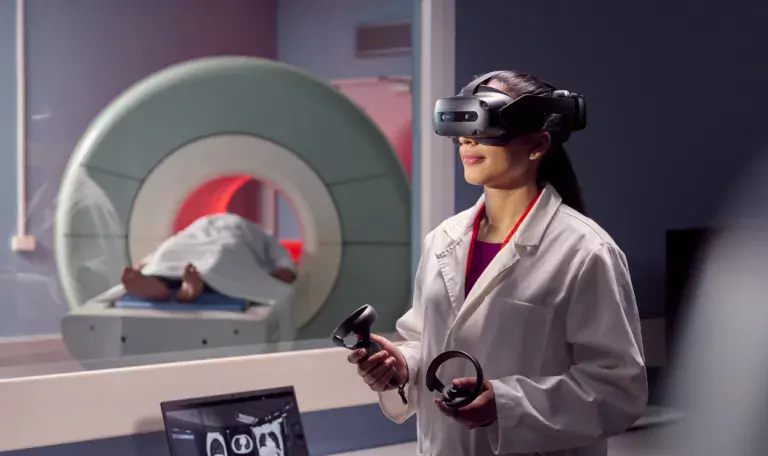An Immersive Technology Transformation: The Future of Patient Care is Here
As the world continues to embrace the notion of digital transformation, new possibilities are emerging in the world of healthcare — but only if you have a processing platform you can trust. Connecting AR/VR glasses to Lenovo devices such as the ThinkPad T14 Gen 4 i on the Intel vPro® platform provides everything you need in one validated solution — empowering healthcare professionals with unrivalled performance power from anywhere. Part of a true end-to-end ecosystem of digital devices and tools, groundbreaking solutions like immersive technology and 3D visualization are leading the push for more innovation. Between improving patient experiences and delivering immersive clinical collaboration, virtual reality (VR) and augmented reality (AR) are at the forefront of this new era. According to a study done by Grand View Research, the AR and VR healthcare market is estimated to grow at a compound annual rate of 27.2% globally between 2021 and 20281. The future of healthcare and patient treatment is here, and AR/VR has a crucial role to play.
Breaking Down the Benefits
With healthcare practices no longer confined to the walls of clinical facilities and imaging labs, access to care and training has become more accessible— but that’s just the tip of the iceberg. In fact, more than 2,200 clinical studies have already been conducted worldwide to demonstrate the benefits in medical training, diagnosis, and treatment — all while delivering extensive data tracking and positive financial outcomes2. Here are some of the ways AR/VR can benefit both patients and clinicians:
Expanded Therapeutic Approaches
Multisensory digital worlds allow patients to experience better experiential engagement during treatment of a variety of conditions.
Improved Patient Outcomes
Using AR/VR to visualize medical imaging datasets allows surgeons and radiologists to better prepare for complex procedures.
Enhanced Provider Flexibility
Clinicians can boost productivity by creating an immersive, expansive medical environment from anywhere — increasing the reach of their care.
Redefining What’s Possible in Early Detection
Virtual reality is empowering advanced diagnostics for physical and cognitive conditions, including those that are difficult to detect. Studies have shown that VR simulations can detect early onset Alzheimer's by testing navigation difficulties or detecting changes in brain activity with fMRI. Patients with mental illnesses can be diagnosed using realistic VR scenarios that test and observe responses to specific situations and experiences, or changes in the brain. This is particularly helpful for conditions such as schizophrenia, post-traumatic stress disorder (PTSD), and anxiety. Additionally, ophthalmologists can map out a patient's visual field and detect functional deficits using VR techniques, such as stimulating specific areas in a patient's visual field. As a hyper-mobile solution, VR technology can be used in a portable diagnostic environment beyond the traditional healthcare facility. VR provides a more streamlined path toward answers for patients that have been historically left without them.
An Easier Road to Rehabilitation
In terms of improving patient outcomes in the rehabilitation phase, immersive technology opens an entirely new roadmap for success. This alternative approach to pain management and rehabilitation reduces the need for sedation and medication, potentially resulting in a quicker and easier recovery. By engaging multiple senses, AR/VR is able to divert the brain's attention from pain signals, improving treatment time and recovery gains. In addition, self-guided rehabilitation exercises and neuro-rehabilitation solutions augment hospital and home care by improving motor control, visual and auditory processing, and other functions. Gamification of physical therapy can also turn rehabilitation into a fun activity — facilitating better learning while improving patient adherence to treatment. By integrating immersive technology into pain management and rehabilitation, patients may experience a more holistic and enjoyable path to recovery.
Boosting Mental Health and Recovery
Virtual reality exposure therapy (VRET) is an innovative approach to improving mental health and recovery through the simulation of real-life scenarios in a safe environment. This technology-based approach aims to decrease stress response intensity in situations that provoke fear or anxiety due to negative memories, thoughts, or experiences. By using multisensory VR to increase the patient's experiential engagement during treatment sessions, VRET has been shown to help individuals feel more comfortable in stressful scenarios, create a calming virtual environment for treating stress, depression, or anxiety, and provide controlled exposure and cognitive-behavioral therapy for patients suffering from PTSD. Additionally, VRET can create immersive experiences for patients with cognitive impairment or dementia that reside in senior living communities, veterans’ homes, and other outpatient centers. This technology can help unlock memories while stimulating interaction and decreasing agitation in a variety of situations.
A Worthy Foe for Phobias
Lastly, virtual reality therapy is an effective alternative for individuals who find it challenging to apply the imaginative techniques required by systematic desensitization — a common therapy for treating phobias. By providing stimuli and practicing helpful ways of thinking and behaving to overcome fear and anxiety, VR therapy returns real-time feedback to clinicians to assess treatment effectiveness and personalize further. Research reviews demonstrate that VR-enabled cognitive-behavioral therapy is effective in treating various phobias — including fear of heights, spiders, and anxiety disorders.
A Complete Healthcare Solution
VR and AR fundamentally change the patient and provider experience with revolutionary possibilities. Together with devices like the ThinkPad T14 Gen 4 i powered by Intel vPro®, Lenovo ThinkReality solutions create boundless new opportunities for forward-thinking healthcare organizations to improve delivery of care today while preparing for tomorrow. Lenovo ThinkReality A3 smart glasses advance what’s possible in healthcare by empowering clinicians with a flexible, expanded workspace that fits in the palm of their hand. Similar in size with a pair of sunglasses, ThinkReality A3 integrates advanced optics technology while providing complete privacy to the wearer. By connecting these glasses to Lenovo PC’s like the ThinkPad® X1 Carbon, ThinkPad® X1 Nano, or ThinkPad® P16 Mobile Workstation, healthcare organizations are empowered with versatile solutions that are performance-engineered for patient care and support a variety of workflows with high-performance functionality — powered by the built-for-business Intel platform.
Begin Your Immersive Technology Journey
VR and AR are fundamentally changing the patient and provider experience with revolutionary possibilities — increasing the importance of processing solutions that can support the wave. Investing in the ecosystem behind an end-to-end healthcare experience is the smartest path to digital prosperity. At Lenovo, our ThinkReality solutions create boundless new opportunities for forward-thinking healthcare organizations to improve delivery of care today while preparing for tomorrow. When these devices are tethered to the unrivaled power of an Intel®-based computer, the flexibility and user-experience become nearly limitless. Designed to give healthcare organizations a boost right out of the box, Intel vPro® empowers you with end-to-end capabilities that include: Platform security, Enhanced productivity, and Modern manageability. Are you ready to begin your immersive technology journey? Learn more on our ThinkReality and Healthcare pages.





